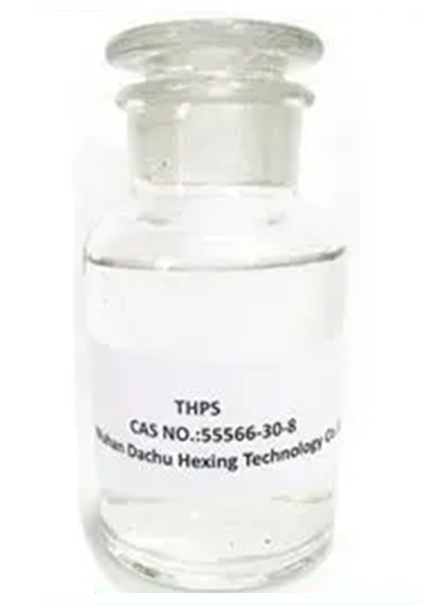We unleash your business potential by maximize the business innovation.
Send EmailTetrakis Hydroxymethyl Phosphonium Sulfate, THPS, 55566-30-8
🧪 General Information
-
Chemical Name: Tetrakis(hydroxymethyl)phosphonium sulfate
-
Common Abbreviations: THPS, THPS 75%, THPS %75
-
CAS Number: 55566-30-8
-
Molecular Formula: C₈H₂₄O₁₂P₂S
-
Molecular Weight: 406.28 g/mol
-
Form: 75% aqueous solution
🌊 Applications
-
Biocide: Used in water treatment systems, cooling towers, and oilfield operations to control microbial growth.
-
Paper Industry: Prevents microbial contamination during paper production.
-
Flame Retardant: Applied to textiles to enhance fire resistance.
✅ Advantages
-
Low Toxicity: Safer than many traditional biocides.
-
Biodegradable: Breaks down into non-toxic phosphonic acid derivatives.
-
Effective at Low Doses: Delivers strong antimicrobial action even in small quantities.
⚠️ Precautions
-
Requires protective equipment during handling.
-
Should be stored away from moisture and direct sunlight.
🧾 Synonyms & Alternate Names
-
Tetrakis(hydroxymethyl)phosphonium sulfate
-
Bis[tetrakis(hydroxymethyl)phosphonium] sulfate
-
Octakis(hydroxymethyl)diphosphonium sulfate
-
Tetrakis Hydroxymethyl Phosphonuim Sulfate (common misspelling)
-
THPS 75%, THPS %75
🗣️ Common Informal References
-
"THPS" (most common shorthand)
-
"Biocide chemical" or "microbe killer"
-
"Flame retardant chemical"
-
"Water system cleaner"
-
"Oilfield treatment chemical"
🏭 Production Process
Raw Materials:
-
Formaldehyde (CH₂O)
-
Trimethyl phosphite (P(OCH₃)₃)
-
Sulfuric acid (H₂SO₄)
Reaction Steps:
-
Trimethyl phosphite reacts with formaldehyde to form phosphonium salts.
-
These salts are neutralized with sulfuric acid to yield THPS.
-
The process is conducted under controlled pH and temperature.
Final Product:
-
A clear, colorless liquid at 75% concentration.
🔄 THPS Alternatives
| Chemical | Properties | Pros | Cons |
|---|---|---|---|
| Glutaraldehyde | Broad-spectrum biocide | Highly effective | High toxicity |
| Isothiazolinones | Antimicrobial at low doses | Cost-effective | Skin irritation, regulatory limits |
| Bronopol | Bacteria/fungi control | Stable, effective | May release formaldehyde |
| DBNPA | Fast-acting biocide | Biodegradable | pH-sensitive, short shelf life |
| Peracetic Acid | Oxidizing biocide | Environmentally friendly | Corrosive, requires special handling |
🧩 Sector Compatibility Table
| Sector | THPS Suitability | Alternatives | Notes |
|---|---|---|---|
| Water Treatment | ✅ High | Glutaraldehyde, DBNPA | Preferred for low toxicity |
| Oil & Gas | ✅ High | Isothiazolinones, DBNPA | Effective for microbial and corrosion control |
| Textiles | ⚠️ Moderate | Peracetic Acid, Bronopol | Used as flame retardant |
| Paper Industry | ✅ High | Isothiazolinones, Glutaraldehyde | Effective microbial control |
| Aquaculture | ⚠️ Limited | Peracetic Acid, DBNPA | Usage restricted in some regions |
| Leather Processing | ✅ High | Bronopol, Glutaraldehyde | Used in tanning for microbial control |
⚗️ Reactions During Use
-
Antimicrobial Action:
-
Penetrates microbial cell walls.
-
Reacts with intracellular proteins → protein denaturation.
-
Microorganisms die; THPS degrades into non-toxic phosphonic acids.
-
-
Flame Retardant Mechanism:
-
Binds chemically to textile fibers.
-
Upon heating, releases phosphorus-based radicals that inhibit combustion.
-
-
Water System Applications:
-
Reacts with biofilms on metal surfaces.
-
Breaks down microbial layers and acts as a corrosion inhibitor.
-
-
pH & Temperature Sensitivity:
-
Stable in neutral to mildly acidic environments.
-
At high temperatures, may decompose and release formaldehyde (manageable under controlled conditions).
-
